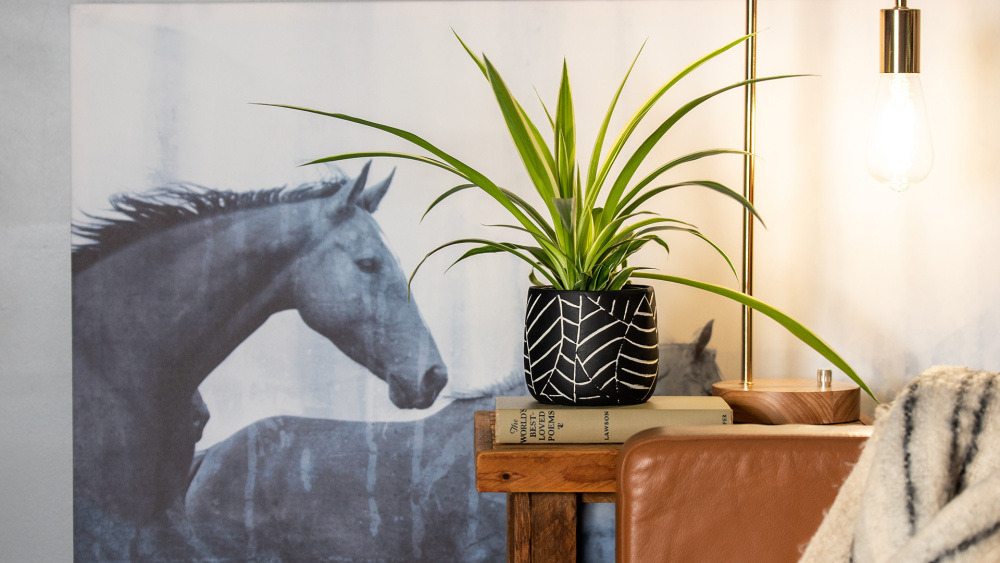
Spider plants (aka Chlorophytum, airplane plant or ribbon plant) are attractive tropical plants, nicknamed for their long, arched, narrow leaves and white stripe down its center. Their cascading nature looks great in hanging planters or placed on a sill or near a ledge to create a waterfall effect. They are originally native to Africa but gained popularity as a houseplant in the Victorian era as fashionable living décor.
Spider plants are perfect for beginners and experienced plant owners. They are easy to care for, can handle moderate sunlight, and are great at purifying indoor air.
Although they bear a similar resemblance to Dracaenas, Dracaena plants tend to have wider leaves and a taller, more upright growing habit.
Mature Spider plants also can produce many visible offspring, called “pups” or “spiderettes” which trail down from the mother plant.
Regular watering, indirect sunlight and regular fertilization are all key to keeping your Spider plant looking its best. Follow this guide to learn more about caring for your Spider plants.
When placed indoors, Spider plants do best in bright to moderate indirect light. Make sure you acclimate your plant before exposing it to full or direct sunlight to prevent its leaves from burning and causing damage.
Spider plants can grow in a variety of different soil types. However, they do best in loose soil with optimal drainage. Spider plants prefer a neutral pH Balance but can handle slightly acidic or higher alkaline mixed soil.
These plants prefer to have their soil kept moist but not overly saturated. Be sure not to overwater your spider plant as it can quickly lead to root rot.
These plants are also sensitive to excess fluoride and chlorine commonly found in tap water. Excess mineral salts can cause brown tips at the end of its leaves.
Therefore, giving your spider plant filtered water or rainwater is best. Make sure the water is room temperature to avoid harming your plant with water that is too cold or too hot.
Giving your spider plant a temperature and humidity that matches its natural habitat is how they will thrive the best. Don’t expose them to cooler temperatures below 50 degrees Fahrenheit and try to keep them away from any cold or hot drafts. Regular misting or running a humidifier in the room can help increase the ambient humidity and keep your plant from developing brown leaf tips.
During their active growing season, spider plants can benefit from regular fertilization. Feeding them once a month using an all-purpose liquid fertilizer that is formulated for indoor plants.
Spider plants are quite easy to propagate, which make them a great plant for a beginner to grow and share with friends. Follow the below steps to ensure a successful propagation.
1. Once your plant has matured and grown pups, you can separate the pups from the mother plant and replant them. Using a sterile sharp knife or pruning tool, carefully cut off a small plantlet off the stem ensuring to keep its roots intact. Be sure that the roots are at least an inch or two long.
2. Place this new cutting into a pot with fresh new moist potting mix. Ensure the soil stays moist but not overly saturated.
3. Once you start to see this new cutting start to grow. You can begin to water and care for it as you would a regular spider plant.
Spider plants will still grow well when slightly root-bound; however, once your plant’s root system and root ball start to overgrow your planter, it’s time to repot. Ensure that your new pot is about 1”-2” inches wider in diameter than the old pot and has good-sized drainage holes at the bottom.
Generally, Spider plants will need to be repotted about once every 2 to 3 years. The best time to report is when your plant is in its active growth stage around the spring or early summertime.
To repot, fill your new pot halfway with fresh moist potting mix. Remove your Spider plant from its old container. Trim any damaged or decayed roots and fill in the rest of the space around the plant using loosely packed indoor potting mix.
If the soil is dry, you can water the plant after repotting, otherwise water as normal. If you see your plant wilting shortly after repotting, the soil may be too dry.
1. How long does spider plant live?
The length of time a spider plant can live is based on how well it is cared for and maintained. Spider plants are known for their longevity, and if cared for properly can live up to 20 or even 50 years(!). Keeping your plant’s soil lightly moist and ensuring it gets an adequate amount of indirect sunlight are the most important factors in maintaining a healthy plant.
2. Does a spider plant really clean the air?
According to the NASA clean air study, Spider plants are listed as one of the best natural home air purifying plants, capable of helping filter common household VOC’s (Volatile Organic Compounds) including formaldehyde, xylene, and toluene from indoor environments.
3. Can a spider plant survive outdoors?
Spider plants can be grown outdoors in warm climate zones (i.e.: USDA zones 9 – 11) , and will not tolerate frost or freezing.